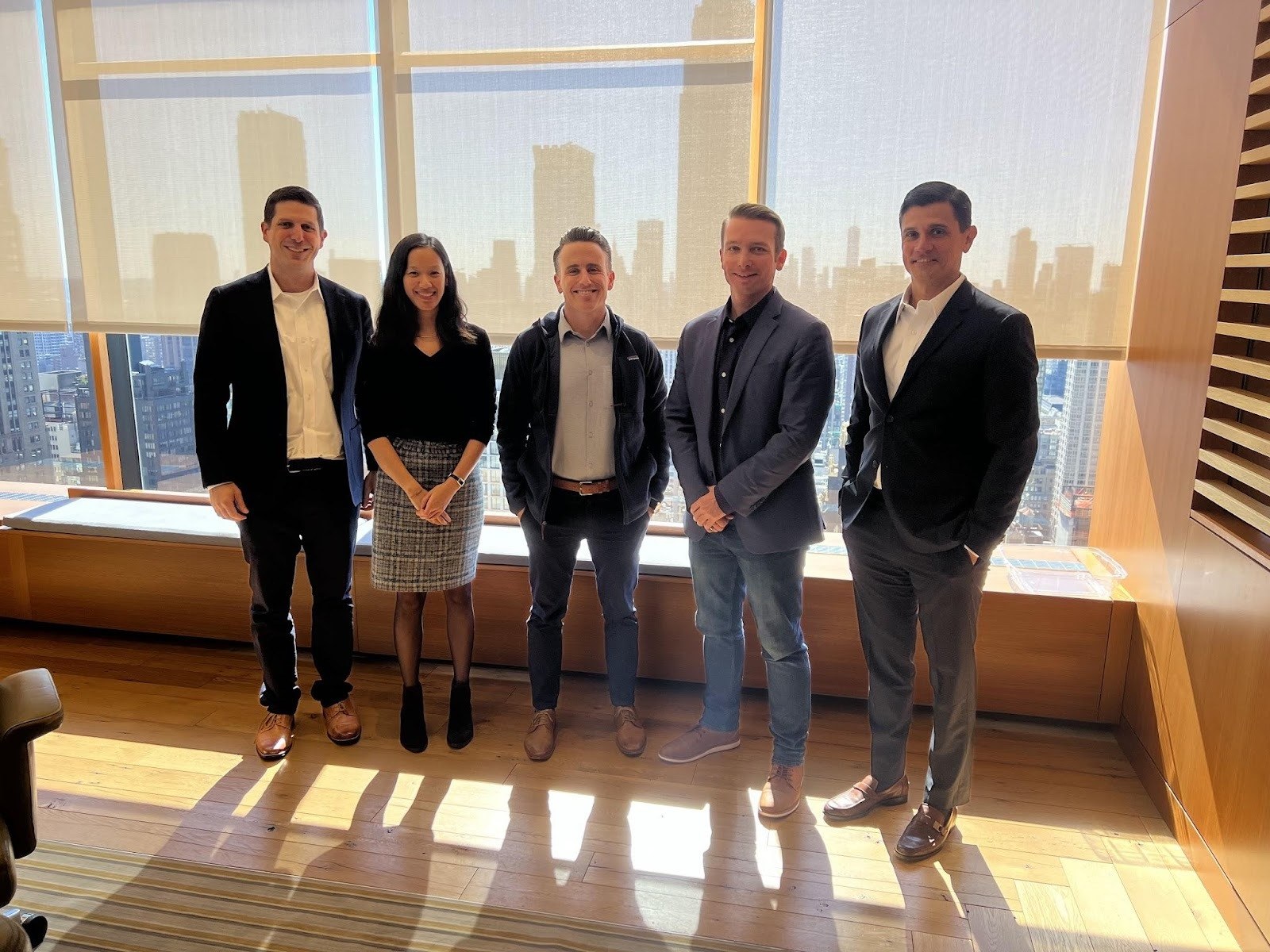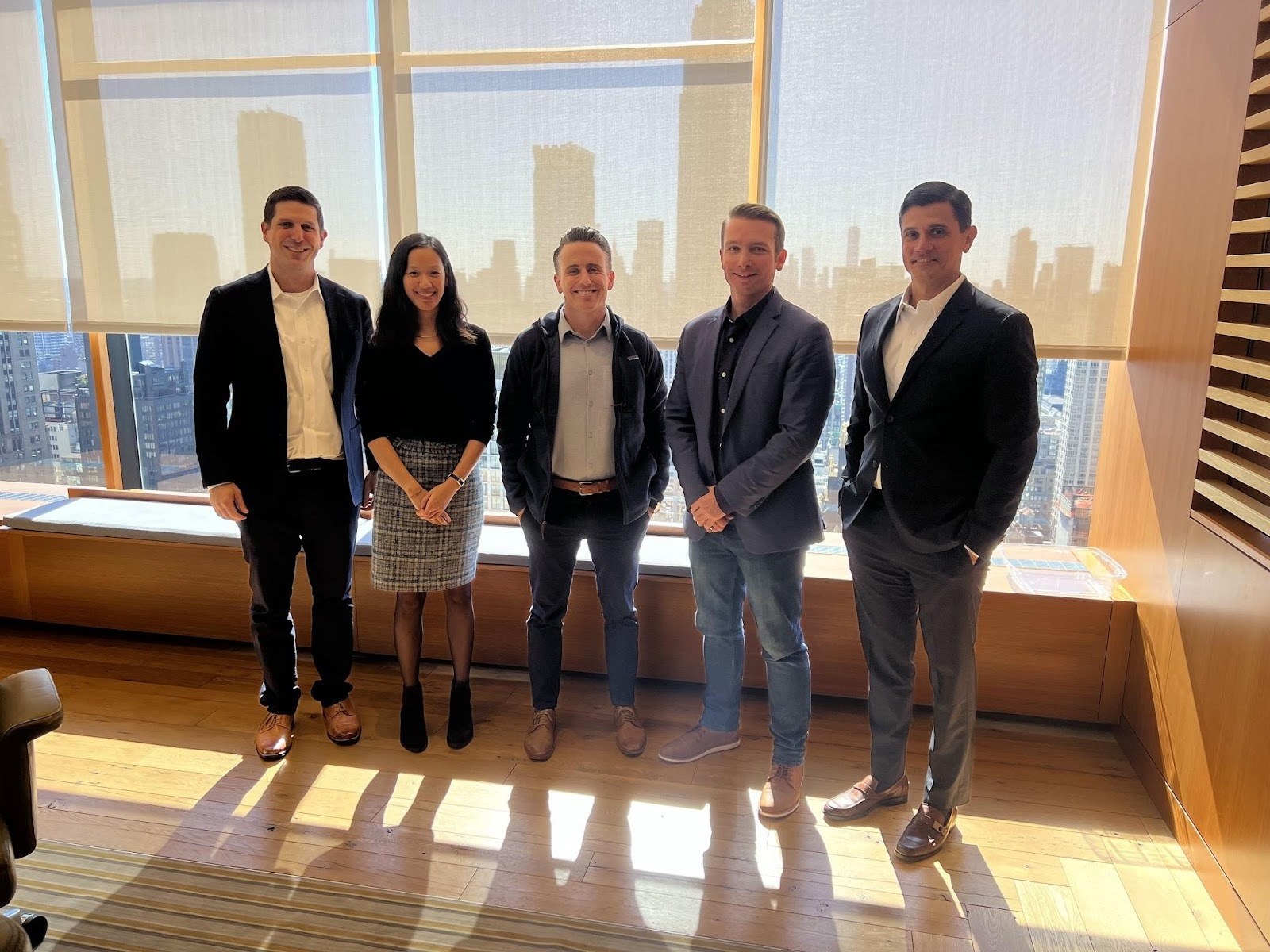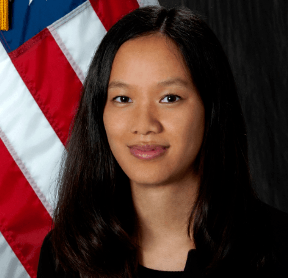Meet Insight’s Third Cohort of Defense Ventures Fellows

Key Ideas
- Insight Partners participates in the Defense Ventures program, which offers immersion opportunities for active duty, reserve, guard, and Department of Defense (DoD) civilians.
- Insight and portfolio companies benefit from the Fellows’ experience navigating unique bureaucratic and functional requirements in the DoD.
- Fellows learn how to evaluate prospective investments and support post-investment portfolio company growth from Insight investors.
The Defense Ventures Fellows program is an immersion program for active military and civilian members of the Department of Defense (DoD), who spend two weeks in a cohort-based training and development, and then six weeks embedded in a venture capital firm or portfolio company—after which they return to the government with new insights about the innovation economy.

Each cohort has generated a knowledge exchange about military service and how the Department of Defense actually works. At Insight, the Fellows are exposed to how prospective investments are evaluated and how Insight supports company growth post-investment. The DoD can be challenging for startups and scaleups, and one area of particular focus with this cohort was getting the Fellows to actively work with portfolio companies, especially those that are primarily focused on national security. This most recent cohort of Defense Ventures Fellows also joined Insight for the October Government Advisory Board meeting, where they had the opportunity to hear Secretary Carter and the rest of the GAB discuss China-US strategic competition and debate investment models for national security-focused companies.
Meet Insight’s Third Cohort of Defense Ventures Fellows
At the end of 2022, Insight hosted Defense Ventures Fellows for the third time. Jamie Johnson, a Space Force acquisitions officer, Michael Baird, an Air Force Foreign Area Officer (FAO), and Georgia Bass, a National Geospatial-Intelligence Agency (NGA) Research & Development Scientist, spent six weeks with Insight Partners and a handful of Insight portfolio companies.
As they return to government service, we asked Jamie, Georgia, and Michael about their experiences working at Insight Partners, what they learned, and what they’ll take back with them to the Defense Department.
What do you see as the biggest challenge for startups and small businesses in bringing in new technology?
Jamie: Acquisition timescales are not keeping pace with technology timescales. This experience helps emphasize the need for PPBE Reform, as well as look at new contracting and funding methods that give these companies a fair look relative to the biggest aerospace companies, especially in timelines that are relevant to dynamic national security threats. Also, acquisition methods don’t align with an ever-increasing software-based world. As the saying goes, “software is never done”. We need to be better at using the software acquisition pathway and other methods for warfighter missions (not just for IT). Finally, we need to rely less and less on the “program of record” (PoR) in the future. The assumption of succession to a PoR seems to be the holy grail for any company or a maturing tech company, but this does not support our software-based, agile, continuous value-delivery world.
Georgia: As a program manager working to bring in new software technology, the greatest challenge I have witnessed is startups and small businesses attempting to stay informed of DoD Cloud DevSecOps services. In addition, the continuously evolving DoD Authority to Operate (ATO) and Interim Authority to Test (IATT) process, creates a difficult landscape for a new company doing business with the Government to navigate. This additional hurdle the startup and small business community faces–especially compared to an established defense contractor–adds to the importance of standardizing infrastructure, platforms, and security authorization processes across DoD agencies and organizations.
Michael: There are a ton of challenges for a startup to realize a commercially viable innovation even without the burden of trying to sell that technology to the government, but doing so makes it doubly hard for all of the reasons that Georgia and Jamie mention. Fundamentally, the problem is that DoD procurement/acquisition processes are not (yet) adequately incentivized to encourage the kind of “move fast and break things” mentality that yields so much innovation in Silicon Valley. It is not impossible, and there are winners that do manage to navigate the bureaucracy, but even when there is a crystal clear operational need and an obvious solution available, there are far too few startups that have enough runway and patience to survive and actually get the kinds of contracts (beyond SBIR Phase I/II) they need to get their tech into warfighters’ hands.
What do you think you will take back to the DoD as a result of this experience?
Jamie: First, I will take back a comprehensive list of barriers to small businesses and startups in doing business with the DoD. Ideally, I also hope to take back ideas to inform a new process to better connect Program Executive Officers, their respective mission areas, and the Combatant Commands they serve with applicable VCs and tech companies. This process would ideally incentivize, “passage through the valley of death” which is unnecessarily ubiquitous in today’s world, and reduce acquisition timescales to better match the technology timescales. This, in turn, makes us more agile with respect to adversary threats, making use of best-of-breed companies and technology.
Georgia: I aim to demonstrate the value of investing in dual-use technology to accelerate innovation within my organization. The first step is to prove “innovation moves at the speed of trust” by building more effective and enduring relationships between VCs, startups, and my research organization. As a program manager, by leveraging non-traditional solicitation vehicles to target expertise from within the startup and small business community, I can directly contribute towards this mission. In addition, working with [Insight portfolio companies] HawkEye360, LeoLabs, Shift5, and Rebellion Defense has taught me ways in which I can more successfully influence the growth of the innovation ecosystem from within the DoD.
Michael: Mostly I’m going to take back a different mindset that is unwilling to just accept the status quo of inferior products/support, especially when I’m now so keenly aware of how much capability lies just out of my reach in the commercial sector. And thankfully, as a complement to this shifted perspective, as a result of the incredible exposure Insight Partners has afforded us, I am now armed with a greatly expanded network of like-minded individuals across both the DoD and the VC/startup community that are actually making real progress.

What advice do you have for start-ups and small businesses to successfully navigate the current DoD acquisition process?
Jamie: I would tell startups to have a clear understanding of what companies are being awarded contracts and why. Also, startups (and VCs) should have a clear understanding of current and future national security threats and the real-world environment, such that the latest high-demand mission areas and capabilities can be identified. Next, I would have startups use DoD’s own words in the way they do their marketing — if the DoD says they want to “buy rather than build”, then make sure every touchpoint with DoD emphasizes that you are enabling buying of products/services and that you do not build long-term, one-off, complex systems. Finally, tech startups would benefit from having subject matter experts (SMEs) that know defense acquisition law and policy as well as operational doctrine.
Georgia: Successfully navigating the current DoD acquisition process requires perseverance and optimism. Ensuring your proposals and pitches align with agency, department, or DoD-wide technology and modernization strategies is critical. In addition, using the Heilmier questions to guide your proposal writing offers a framework to demonstrate: how your solution supports a current DoD priority, reinforces why it is a novel approach, what are the risks, and (my favorite) if you are successful, who cares and what difference will it make? As a program manager, I often refer to these questions when evaluating new technology or even when critically assessing my own program.
Michael: I’ll echo Georgia and Jamie’s answers here and double down on the necessity of perseverance and the need for SMEs with experience navigating the DoD Acquisition process. Founders must walk in with eyes wide open and recognize that even when there is a clear product-market fit and an obvious operational necessity, there is so much red tape to cut through to actually help the DoD help itself. The process is improving on the margins, but it is not yet where it needs to be to ensure the best companies with the best tech rise to the top. In the meantime though, as we’ve seen from our experience with [Insight portfolio companies] Shift5, Hawkeye360, Rebellion Defense, and LeoLabs, partnering with the right VC firm with the patience and expertise to help their companies navigate DoD processes is a model that can be very successful.
As a result of the Defense Ventures Fellowship, have your career objectives changed in any way?
Jamie: As someone always interested in the world of entrepreneurship, having spent a fair amount of time and effort building apps, this has given me a much better view of how the best companies operate and communicate value to potential customers including the DoD. Also having been a consultant in the past, it was reassuring to see how firms like Insight Partners take good care of the companies they invest in, even with respect to improving and optimizing their organization and culture. So the experience has inspired me to take another look into running my own company in the future, while thinking deeply about how to improve the “startup” culture of our new Space Force.
Georgia: Working at Insight Partners has reinforced my desire to continue building relationships between the DoD, VC, and tech startup communities. As mentioned earlier, I believe “innovation moves at the speed of trust” and participating in this fellowship has broadened my horizon to how the DoD, VC, and tech startups accelerate the innovation space. The Defense Ventures Fellowship gives me perspective on how the innovation ecosystem currently operates – and it is now my responsibility to define how I want to make a difference within it.
Michael: Most definitely. My eyes have been opened to a whole new world of opportunities to make a difference for US national security that I didn’t know existed, and further, through the experience, I feel empowered to be able to actually implement those needed changes while still in the DoD as well as afterwards in the commercial sector. That being said, I’m looking forward to first taking this broadened perspective to continue doing what I can to help ensure Ukrainians get the relevant capabilities they need now to defeat Russia, and to help us learn as much as possible from that conflict to ensure our own warfighters have what they need to deter and/or defeat future adversaries.
What was the most unexpected thing you learned from your experience as a Defense Ventures Fellow at Insight Partners?
Jamie: I learned a ton about the commercial startup economy, its breadth, and most of all its potential impact in supporting national security. I was greatly surprised to see all the defense technologies and businesses constantly flowing in for consideration by a VC, making this a fascinating experience. At the end of the day, especially during the current economic downturn, I think there are ways we can better connect the DoD with this flow of tech and ideas such that VCs can have a better idea of what the DoD needs, and in return, the DoD can have a better real-time knowledge of emerging tech.
Georgia: I was surprised by the relevancy of the VC-backed dual-use technology startup community to support US engagement in strategic competition. I gained a new perspective on how the VC community’s strategic approach to targeted market growth and customer demand can also be applied to ensuring US national security by encouraging the growth of a US-based emerging technology market. I aim to apply the VC evaluation methodology to my future work at the intersection of technology, policy, and innovation.
Michael: Well, I expected to learn about a few innovative companies working on fascinating and creative ways to solve DoD problems, and about the VC community’s perspective on why they are worth investing in (i.e. how a VC firm evaluates a deal) but I suppose the most unexpected thing for me was a realization of just how much potential lies just out of our reach as military operators because of sub-optimal DoD acquisition processes. That is, there is so much useful tech out there that could already do so much good if only we could more efficiently get the product to the DoD market.
Based on your current experience and where you work, what capability does the DoD need right now?
Jamie: The DoD needs help with decision-making to support multi-domain operations, deliberate planning, and crisis action planning, taken together can be referred to as mastering decision superiority. This starts with quality software and the space domain and in the future will involve artificial intelligence supplementing operators who may have to react to dynamic threats on very tight timelines. There has been a lot of attention here in the last few years, but many of the efforts are still maturing and improving. There is opportunity here, especially in the way Combatant Commands operate and are fed new capabilities by the services. Furthermore, significant work is required in optimizing how the US executes command and control with other ally countries.
Georgia: To accelerate innovation within DoD, there needs to be more efficient interoperability between systems to integrate software faster. Evolving existing API management practices, standardizing DevSecOps processes, and leveraging cloud infrastructure to create shared environments will enable the DoD to more easily adopt commercially developed technology. I believe that the process of reshaping and modernizing the underlying DoD software architecture is the capability the DoD needs right now. As the DoD receives more GEOINT-derived information – accurately processing, analyzing, and disseminating insight to customers will also be aided by automated insight and reporting tools.
Michael: For the last 8 months I’ve been intimately involved and watching the war unfold in Ukraine, and from a defense-related tech perspective, I’ve been struck by a number of things. First, the pace with which Ukraine has been able to fuse commercially available technology with legacy post-soviet and NATO systems to achieve immediate battlefield impact is staggering. Second, while the US defense industry has been able to provide legacy equipment and munitions at scale, it has faltered in nearly every case where innovative (and often cheaper) niche solutions were necessary to meet an urgent operational need. The commercial sector stepped up in several cases to fill this gap with dual-use technology (Starlink, for example). Third, and to more directly answer the question, we in the DoD need to learn a lot of lessons from the Ukraine fight and invest heavily in capabilities that are able to fuse multiple sources of intelligence and quickly enable the employment of a multitude of relatively cheap and attributable autonomous/semi-autonomous systems (UAVs, etc.) that can operate in GPS-denied environments.
As Nick writes about in his new book, Hack Your Bureaucracy, the concept of “people flow”—fellowships, internships, externships—helps bring new energy, skills, and experiences to organizations. The Defense Ventures program has brought much to Insight, and we’re optimistic that it strengthens the DoD as this cohort returns to their respective missions.
Catch up on the first and second cohorts of Insight’s Defense Ventures Fellows.

Lieutenant Colonel Jamie Johnson is a Space Force acquisitions officer, serving the past few years as the Director of Space Systems Command’s AtlasX Business Innovation unit, which proliferates entrepreneurship, agile methods, and data analytics to ultimately modernize the way we work. Jamie is a Department of Defense (DoD) Career Intermission Program alumni, competitively hired during his break from active duty into senior-level roles at LinQuest Corporation and Deloitte Consulting LLP, gaining outside systems engineering and consulting expertise to bring back to the service. Jamie held previous Air Force leadership roles in space control, launch, and propulsion research and development, along with a deployment managing a 24/7 communications aircraft fleet in Afghanistan. He loves to learn and has multiple degrees and certificates in engineering and business including a PhD. He recently completed a program aimed at solving global space & defense challenges with joint DoD leaders. He is an avid student of cognitive psychology, organizational behavior, systems thinking, and culture, and was a key contributor to the Space Force’s Guardian Ideal human capital strategy. Jamie is a native of Doylestown, PA, and enjoys running the hills of his Palos Verdes Estates, CA neighborhood and spending quality time with his two teenage boys.

Georgia Bass is a research and development scientist at the National Geospatial-Intelligence Agency. Currently, Georgia is a program manager co-leading a multi-million-dollar research program supporting NGA’s data integrity and data assurance Tech Focus Area. She is passionate about bridging the domains of cybersecurity, GEOINT, and strategic studies as they offer an innovative framework to develop technologies that address emerging space-based threats. Georgia was a Champion Team Lead in the 2022 NGA Technology Accelerator where she fostered structured engagements between NGA and a technology start-up and exposed relevant NGA groups to emerging commercial technologies. She has previously interned at the Office of the Director of National Intelligence supporting the Office of Lateral Innovation and the United States Africa Command as a geospatial analyst. Georgia holds a Master’s Degree in Global Security Studies with a concentration in Strategic Studies from Johns Hopkins University, as well as a Bachelor’s Degree in Political Science and Geography from the University of Massachusetts Amherst Commonwealth Honors College. She is an alum of CyberCorps Scholarship for Service and a member of the 2022 Emerging as a Global Leader Experience Program Cohort.

Lieutenant Colonel Michael Baird is an instructor at the Defense Intelligence Agency’s Joint Military Attaché School and has spent 19 years in the combat aviation and intelligence communities as a fighter pilot, special operations pilot, and military diplomat. In addition to revamping the school’s cybersecurity curriculum to reflect the realities of ubiquitous technical surveillance that these personnel will expect while serving abroad, Michael helps to teach the navigation of cultures, languages, ambiguity, and resource constraints to foster cross-cultural relationships specifically in the interest of ensuring senior decision-makers and the US policy-making establishment are well-informed. As a result of Russia’s invasion of Ukraine, and Michael’s depth of experience there, he has been serving since April as a Ukraine Subject Matter Expert (SME) at European Command (EUCOM) in Stuttgart, Germany. Michael has over 2,500+ hours of flight time in the U-28 and F-16 and has served as an Air Attaché at the US Embassy in Kyiv, Ukraine and as the Senior Defense Official at the US Embassy in Bishkek, Kyrgyzstan. He speaks Ukrainian and Russian, and in addition to completing a prestigious fellowship in Lviv, Ukraine as an Olmsted Scholar at the Ukrainian Catholic University of Lviv, Michael has a Bachelor of Science in Electrical Engineering from the University of Notre Dame and a Masters of the Arts in International Relations from the University of Oklahoma.








